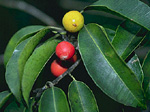 |
This widespread family characteristic of warm, lowland, tropical regions is poorly represented in Australia, where various species may be found in rainforests, monsoon forests and scrubs from the Kimberley region of Western Australia, across Northern Australia and coastal Queensland to northern coastal New South Wales.
Characteristic features of the family Sapotaceae in Australia include:
- trees with simple, entire, alternate leaves, usually with white latex
in the stems and bark
- flowers small, regular, cream or white, often fragrant at night, with
4, 6 or 8 sepals and the same number of petals, the latter fused at
the base
- stamens 4–8, irregularly arranged or alternating with sepals;
staminodes usually present
- ovary superior with a simple style and knob-shaped stigma, developing
into a fleshy or somewhat woody berry
Description
Evergreen, deciduous or semi-deciduous trees or shrubs.
Stem internodes terete, or oval, or slightly flattened. Internal secretions
of milky sap (latex). Plants apparently glabrous, or with simple or dendritic,
non-glandular, uniseriate hairs. Leaves alternate and spiral, or distichous,
or in whorls or pseudo-whorls, petiolate; pulvinae present or absent.
Stipules absent, or present and distinct and free from the petiole, scale-like,
membranous or bristle-like, falling off early or persistent. Lamina simple,
symmetric, lanceolate, ovate, elliptic, oblanceolate, oblong or orbicular;
base cuneate, attenuate, rounded, cordate or oblique; margins entire,
±flat, revolute or recurved; venation pinnate, with the midrib
conspicuous, and the tertiary venation reticulate; surfaces not punctate;
leathery or herbaceous. All the flowers bisexual, or with bisexual flowers
occurring together with either male or female flowers on the same plant,
or with bisexual flowers and both male and female flowers occurring together,
or male and female flowers occurring on separate plants. Inflorescences
axillary, cauliflorous or ramiflorous, consisting of panicles, cymes or
solitary flowers. Bracts present. Bracteoles present or absent. Flowers
fragrant, stalked. Floral disc present or absent. Free hypanthium ±present.
Perianth regular, of 2 dissimilar whorls, imbricate in bud. Calyx segments
free or fused, with 4–12 sepals or lobes, herbaceous. Corolla segments
fused, with 4–8 lobes, alternating with the sepals or calyx lobes; corolla
wheel-shaped, cup-shaped or tubular, white, cream, yellow, red or green,
without contrasting markings, membranous; claws absent; lobes ±entire,
or trifid, trilobed or more divided, or ciliate or fimbriate. Fertile
stamens 4–8, alternating with or not clearly correlated with the sepals
or calyx lobes, at least partly fused to the corolla, free of the ovary
and style, distinct from each other, all ±equal. Staminodes present.
Anthers dorsifixed or basifixed, versatile or not versatile, opening outwards
or sideways by short slits or by longitudinal slits, 2-celled. Ovary superior
and sessile. Carpels 2–14 (–30), fused; ovary with 4–14 locules. Style
terminal, single and unbranched, with the stigma truncate or capitate.
Ovules 1 per locule, sessile; placentation basal or axile. Fruit a fleshy,
indehiscent berry; the perianth on the maturing fruit deciduous, or dry
and persistent. Disseminule micro-surface ±smooth, white, yellow,
magenta, purple, violet, green, brown or black, glossy or dull. Seeds
1–6 per fruit. Aril absent. Cotyledons 2. Embryo straight.
(Note: this description has been generated from the coded data compiled for the key. Any errors in the key data will be reflected in the descriptions.)
A treatment of the family Sapotaceae has not yet been published in the Flora of Australia. It will appear in Volume 10.
Australian genera of Sapotaceae (as recognised for the Flora of Australia)
Amorphospermum
Beccariella
Chrysophyllum
Manilkara
Mimusops
Niemeyera
Palaquium
Planchonella
Pouteria
Sersalisia

|
  |

Amorphospermum whitei (flowers)
Photo: M.Fagg © M.Fagg

Amorphospermum whitei (fruit)
Photo: D.Jones © D.Jones

Manilkara kauki (flowers)
Photo: D.Jones © D.Jones

Mimusops elengi (fruits)
Photo: H.Nicholson © H. & N. Nicholson

|
 |
|